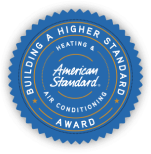FAQ Series: Plumbing, Part 1
We get asked questions all the time by customers that call in, customers we see at events, and even people our techs run into just in passing! So, we decided we would put together a blog series about some of these frequently asked questions! We’ll touch on garbage disposals, water pressure, toilets, water heaters and even sump pumps!
Why does my kitchen faucet have low water pressure?
Today’s faucets are designed to conserve water and almost always include aerators. The aerators are made up of a disk with many extremely small holes with which the water must flow through. Oftentimes, these tiny holes get clogged with lime and/or sediment buildup which will block the water flow and minimize water pressure.
Thankfully, this is pretty simple to resolve. Follow these steps to remove and clean the aerator:
- Unscrew the aerator from the faucet by turning it counterclockwise. If it will not unscrew by hand, cover the jaws of your pliers with masking tape (to prevent damage to the faucet) and loosen the aerator. Once it is loosened, continue remove with your hand.
- Take apart the aerator and/or spray head.
- Dip a small brush in vinegar and gently scrub the parts clogged with sediment/lime.
- Reassemble the pieces and screw back onto the faucet.
Why is my garbage disposal making a humming noise?
The garbage disposal is most likely jammed. Follow the following steps:
- Immediately turn the disposer off and unplug it from the wall socket (or at the circuit breaker).
- Remove any foreign objects from the disposer.
- Most garbage disposers have a port at the bottom where you can insert a ¼” Allen wrench (usually supplied with the disposer) to loosen any objects.
- Reset the disposer by pushing the red button located near the port at the bottom of the disposer.
If your disposer does not have a port at the bottom, or if you can’t turn the wrench to alleviate the issue, call F. H. Furr today.
How do I shut the water off to my entire house?
The main (shut off) valve turns off the water to the entire house and is usually located near the water meter where the service enters your home, or near the hot water heater. To close the valve, turn clockwise until it stops. In the event that you must contact the municipality to turn your water off, be advised there may be a service charge. If a registered plumber is doing any repairs they can make the request with the municipality on your behalf to either turn on or off the water.
Does my sump pump need a dedicated power supply?
The power supply to a sump pump should not only have a dedicated outlet, but should also be a Ground Fault Circuit Interrupter. The sump pump needs its own circuit breaker to prevent tripping of the breaker and the Ground Fault Circuit Interrupter is essential in preventing electrical shock.
It sounds as if water is constantly running, what’s causing this and what can I do?
Chances are likely the fill valve is set at such a tall height that the water level doesn’t completely shut off because the float doesn’t rise enough to shut if off. You need to either adjust or replace your fill valve.
Why am I not getting enough hot water?
It could be a number of reasons from your water heater being too small in which case you may need a larger capacity model, or it could be that you have low gas pressures, or you may need to increase the temperature on your thermostat. But be careful, increasing the temperature can lead to burns and scalding. Another possible cause could be the increase of lime or sediment build-up in your tank. Draining this build-up could help.
What does a Water Pressure-Regulating Valve do?
A water pressure-regulating valve reduces the incoming water pressure from the city’s main water line in order to provide your home with a lower, more functional water pressure level. This valve also regulates the pressure to ensure your home is provided with consistent water pressure (typically 50 lbs). By keeping the water pressure consistent and at lower levels, your home piping and appliances are operating under safe and reasonable pressure.













